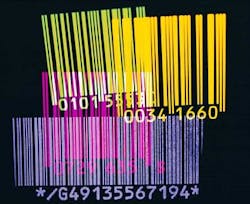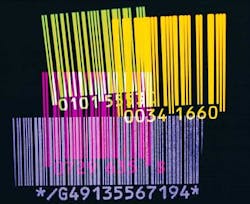laser coding makes its mark
Marking and coding of products, a process now accepted as commonplace, first began with expiration date applications in the food and pharmaceutical arenas. Today products in virtually all industries are routinely coded as part of the manufacturing process. In addition to expiration dates, products are regularly coded with lot codes, real-time dates, barcodes and myriad other information. This enables the manufacturer to trace the product as needed and offers the consumer some measure of security in the purchase. Coding is also an important part of any quality program, whether it is "6 Sigma" or another type of Total Quality Management (TQM) system.
Traditionally, the most common technologies used in the marking and coding of products and packages apply ink, transfer a code or apply a label to create the mark or code. These technologies include:
- Thermal transfer coders—which use heat transferred to the back of a ribbon that has ink on the front side to print variable information such as date, lot, manufacturing line information, barcodes and real-time data onto individual product packages.
- Mechanical embossing systems—which create marks by pressing or stamping a code into a package.
- Ink jet printing systems—which print on primary packages and cartons by jetting ink through addressable print heads to create a range of data from simple date coding to logos, barcodes and serialization.
- Print-and-apply label systems—which apply pressure-sensitive labels to shipping boxes. The labels are printed using thermal transfer technology and normally contain barcoded tracking and content information.
While each of these methods has advantages that make them suitable for specific applications, recent technological advancements have allowed the entry of lasers into more marking and coding applications, giving manufacturers another option.
Lasers and coding
Laser coding technology utilizes the processes of ablation and engraving. Ablation is the process of removing material such as a layer of ink on a printed package. The process uses just enough energy to convert the moisture in the ink into vapors and ablates the ink from the substrate. The key is efficient use of the laser's energy to make the process cost effective. Engraving uses an appropriate amount of laser energy to melt or etch a fine groove into materials such as PET (water and soda bottles), polystyrene (PS) and polypropylene (PP). The end result in both cases is a high-quality permanent and immediate code.
There are three types of laser marking: vector, dot matrix and the dot matrix concept employed by SmartLase laser coding systems. SmartLase coders from Markem (Keene, NH) use a low-power CO2 laser that requires minimal maintenance, is environmentally friendly and produces high-quality permanent and immediate codes. Vector marking produces codes of graphic quality, however, the process is slower and less energy efficient than dot matrix marking. Graphics are created in vector marking by two rotating mirrors and a focusing lens, which is turned on and off, moving the beam slowly to create the image. Dot matrix marking produces images that are of lower resolution, but the system is faster because it marks on less area. Codes are created with dot matrix marking by a laser that goes through a spinning polygon, which then passes the beam to a water-cooled dump. However, dot matrix marking is inefficient with short dwell times of approximately 10 percent that require high laser power (typically 100 watts) to ablate ink. The SmartLase printing concept utilizes a dot matrix approach that delivers codes with the speed of the dot matrix process and the graphic quality of the vector marking process. This process is extremely efficient with 95 percent of the laser operating time spent coding.
Why laser coding?
When compared to competitive forms of marking and coding, lasers appear poised to become the universal method of choice. Key factors include no consumables cost, low maintenance costs, less system downtime, environmental considerations, capability to code on a variety of substrates, ease of integration and user interface.
Laser coding technology is a universal method of package marking compared to other competing technologies offered in the market today. Laser coding is inkless, clean and environmentally friendly and requires no consumables for daily or routine maintenance. This factor, combined with print performance that delivers sharp, immediate and permanent codes makes laser coding a productive coding solution.
Laser coding systems have the inherent capability to accomplish marking jobs with minimum downtime due to the accessories, tools and techniques that accompany the systems. Additionally, many industries, such as frozen foods, pet foods, medical devices, consumer products and automotive components to name a few, require the digital data entry and permanent coding that lasers offer.
Digital data entry is fast becoming mandatory in many industries due to current market needs that include the fact that coding is an area of focus for management in almost every business and the realization of the payback received if a product is recalled and the increase in coding detail that enables the reduction of the recall size. Other factors are the coding mandated by regulatory agencies and restrictions of toxic material usage in the manufacturing process; and the need for environmentally clean and easy-to-use coding solutions.
Lasers are capable of coding on a broad range of materials, adding to their versatility as a coding solution. They are currently being used to code on: paper labels, printed cardboard (cereal boxes, for example) and PET, waxed cardboard, PS, PP, PVC (vacuum formed packages), painted metal, ABS and glass.
Laser versus ink jet
Laser coding, when compared to the current most popular form of coding technology, Continuous Ink Jet (CIJ), offers significant advantages in almost every category.
Laser coders feature easy integration into assembly lines (due to the small size of the machine and variable position output lens), low capital cost and safe, low-power carbon dioxide laser radiation. For example, SmartLase coders are based on a dot matrix system concept, which covers a reduced area of a printed section, and therefore creates codes faster.
Ink jet print systems have a high cost of operation—the average is $6000 per year. These costs include: from $2000 to $3000 per year for consumables; from $3000 to $4000 per year for maintenance based on four to six hours per week; extensive morning start-up times of up to an hour; loss of packaging due to code smearing as a result of wet ink; and overall system downtime.
Other key technical benefits of this system include: low cost as compared to CIJ systems, with exceptional reliability with a Mean Time Between Failure (MTBF) of 20,800 actual accumulated testing hours with no reported failures, and an MTBF point estimate goal of 27,000 hours. Lasers offer variable dot matrix coding density and size, adjustable and programmable pixel size, continuous visual outline bordering the area to be coded, and a rotating printing field.
They also have the capability to print codes 90 degrees to the direction of motion and to code on packages that are stationary or moving.
CIJ print systems, on the other hand, are messy to operate with ink leaks and splashing; require a great deal of maintenance; are dependent on manufacturers for both ink and parts; and have the inherent concern of mixing toxic ink with products.
Conclusion
Today many marking and coding applications are ideal for the advantages offered by a laser coding system and the market is ready to transition its coding needs to laser coding technology. More than 50 percent of existing coding applications can be satisfied at this time with a laser coder. Furthermore, material and line speeds on these coding applications are thoroughly compatible with laser coders without any modifications. Laser coders significantly reduce the cost of product coding while increasing overall productivity.
Shlomo Assa is president of LaserInk Corporation, a division of Markem. Contact him via e-mail at [email protected] or via telephone at 858-618-1482.

